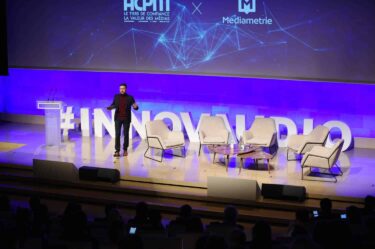Whether it’s to federate and engage a community, attract new audiences, certify ownership or source of content, the uses of blockchain and NFTs are numerous.
What is an NFT?
An NFT (Non-Fungible Token) is a digital file to which is attached a digital certificate of authenticity that makes it unique and it certifies its ownership. This cryptographic token is stored on a blockchain (a transparent and secure information storage and transmission technology).
The buyer of an NFT becomes the exclusive owner of a digital asset which can be a photo, a painting, a music, a video… An NFT is unique, it guarantees the exclusive ownership of a digital asset, its market value can fluctuate with time, it is non-fungible, unlike a fungible currency for example where a 5$ bill is worth another 5$ bill.
The “NFT MANIA”, a worldwide success (but losing momentum?)
Salim Jawad, Head of Creative Innovation at ‘Believe’ declared at the conference Influence of Innovation at the AudioMoves by NRJ GLOBAL event that “the NFT is a real social phenomenon that can be found everywhere today”. It affects a variety of sectors: music, automotive, history, fashion, media and many others. Whether in the United States or in France, NFTs have become real commercial and strategic issues. Several media outlets have taken initiatives in this area, and simply communicating on the subject is attractive.
This year, 20 minutes, daily french newspaper, launched “20 Mint“, a free magazine that deciphers blockchain, NFTs and the metaverse. It is a magazine entirely dedicated to technological developments related to blockchain. To finance the magazine and recruit the teams responsible for its design, 20 minutes has put up 999 unique NFTs on Ethereum for sale. Each of these NFTs gives its holder the power to sit on the virtual editorial board of 20 Mint via a Discord channel, and they all found takers in less than a day.
This type of digital object makes it possible to create playful environments to captivate enthusiasts. This is how Warner Bros called upon the Nifty’s platform to promote the release of the fourth opus of “The Matrix”. 100,000 avatars representing characters living in the matrix were put on sale for 50 dollars against a token. For U.S. networks, NFTs represent a new connection to their most loyal listeners. CNN is now selling NFTs linked to pieces of video about important moments in history. ViacomCBS is working with an NFT platform to launch a space where fans can sell, buy or store tokens linked to the group’s franchises such as MTV or Paramount Pictures.
NFT’s global market capitalization has grown from $40.96 million in 2018 to nearly $338.04 million in 2020. Despite skyrocketing growth and an all-time high of nearly $3 trillion in November 2021, the market’s capitalization has collapsed by more than 50% this year, according to Statista. This figure is still twice as high as the value at the end of 2020.
Radio stations are also joining the NFT movement
Fun Radio and NRJ both joined in the NFT business, and we had the chance to meet them at various conferences to learn more about their projects. During the Paris Radio Show, Alix de Goldschmidt, product and innovation manager at M6 and Fun Radio, told us about their attempt to get into the NFT business: “the subject of NFT is becoming more and more popular, but be careful, you must not propose absurd projects. Fun Radio offered to acquire a collection of NFTs during the Fun Radio Ibiza Experience and the results were better than we expected. The NFT were sold out very quickly.”
Their project, carried out with Atlanticus Music, consisted of selling 10 NFTs that combined immaterial value (a visual and sound work of art) and material value (a VIP ticket for the 6th edition of Fun Radio Ibiza Experience and drinks included). The buyers that were seduced by the operation now form a community and do not hesitate to show it on social networks through their profile pictures for example.
Most NFT collectors, whether they are famous personalities like the Brazilian footballer Neymar or unknown, choose to display their biggest NFT in their profile picture. During the last NRJ Music Awards, the NRJ team also put on display their biggest NFT.
Why are the media interested in blockchain?
Lately, blockchain networks are no longer exclusively associated with cryptocurrency. The use of blockchain has advantages such as the speed of transactions, gains in productivity and efficiency, or ensuring the security of the system. The blockchain is already present in several sectors such as banking, insurance or logistics and others could be added like the media.
Indeed, it could play a decisive role for the media in the protection of content or financing models. Lack of security has always been the haunt of the media, but this has been further reinforced by the rise of cyber-malware such as phishing, hacking or personal data breaches and blockchain could be the solution to all of this.
In addition, the recorded distribution of music or movies would allow artists to be paid fairly by keeping accurate data on streams and purchases. Blockchain allows for a source of truth to be agreed upon in order to establish the origin of a story through blockchain. There are several blockchain media companies: Mediachain and Fluz are the two largest U.S. companies of this type. Mediachain uses blockchain to automatically connect the author and his music and provide information about the music, the producer and the lyrics. Spotify, won over by this blockchain, is buying Mediachain to solve the problem of attributing music to rights holders and artists played on its platform. Fluz, meanwhile, offers discounts for purchases from major brands like Nike or Uber. Fluz users must invite friends, share content and grow their networks to earn as much as 8 percent off personal purchases. Blockchain in the media industry is creating bold possibilities and can be a real asset for media.
NFTs and blockchains now seem to be key issues for the media, which has been ramping up initiatives in the field. The real question no longer seems to be: is it useful to adopt blockchain or NFTs but rather, what is the right way to use them? Despite the volatility of NFT prices, it seems important to take the plunge and experiment by creating NFTs that make sense, that are in line with the company’s mission and whose strategy combines digital and physical, to federate and engage a community, attract new audiences, certify the ownership or source of a content.
The “NFT MANIA”, a real Web 3.0 challenge of today and tomorrow, can be supported by new media specialized in the subject, such as The Big Whale or 20 Mint, to better understand the stakes of this rapidly growing subject.






